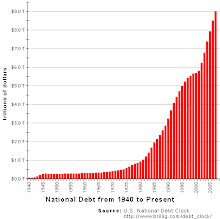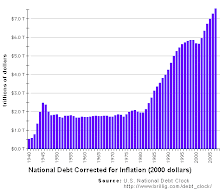
One of the most significant determinants of a country's economic well-being is overall spending on newly produced goods and services, which economists call aggregate demand (AD). Overall spending needs to be large enough to keep unemployment low, yet small enough to keep inflation low. Aggregate demand should not be too large or too small. Like the porridge, chair, and bed in the story of Goldilocks and the Three Bears, an economy's overall spending needs to be "just right."
Insufficient overall spending causes economic recessions and depressions. As aggregate demand declines, businesses sell fewer goods and services. Inventories of unsold products increase, leading to fewer factory orders for newly produced goods. Businesses lay off workers as production and sales decline. The unemployment rate increases as more workers become unemployed. The rate of economic growth, which is measured as the percentage change in output, decreases.
Excessive overall spending causes inflation, which is a general increase in the price level. During periods of inflation, the prices of most goods and services are rising. Inflation is similar to the rising prices of scalped tickets to a popular concert or sporting event. If a society tries to buy more goods and services than the economy is able to produce, the prices of most things will increase.
If society wishes to manage the natural fluctuations in economic activity, called business cycles, it needs to alter overall spending on newly produced goods and services. Thus, there can be a role for government in managing the economy when the consumption and investment actions of households and businesses fail to provide socially desirable outcomes.
When low unemployment and increasing inflation suggest the productive capacity of the economy is unable to meet the demand for goods and services, the appropriate policy is to discourage spending through contractionary monetary policy (higher interest rates, fewer bank loans, and a smaller money supply), and contractionary fiscal policy (higher taxes and reduced government purchases).
However, when unemployment is relatively high and economic growth is small (such as in the current recession), the appropriate policies to pursue are expansionary monetary policy (lower interest rates, more bank loans, and a larger money supply) and expansionary fiscal policy (lower taxes and increased government purchases).
In the current U.S. economy, monetary policy has been largely ineffective. Interest rates are about as low as they can go. (The federal funds rate is 0.25%. It is almost zero.) Because of the financial crisis, banks are reluctant to lend money. Tax cuts have been largely ineffective as well. Studies show most recipients have used the additional funds to pay down debt rather than increase purchases. So that leaves increased government spending as the most viable way to increase the aggregate demand for newly produced goods and services.
Thus, the economic justification for government spending programs to stimulate the economy is that they can increase aggregate demand when consumers and businesses and unwilling to do so.
If one's primary concern is economic recovery, then the spending should be done as quickly as possible on projects that employ workers in the production of new goods and services. However, there is a tradeoff between projects that can be done quickly, and those that provide the greatest long-term benefit. This has led to criticism of U.S. government stimulus spending. Projects that can be done quickly are criticized for lacking long-term benefit. Spending for more worthy projects is criticized because it is not helping the economy quickly enough. This is why defenders of stimulus programs argue we need to give them more time. Much of the spending was designed to help over the period of several years, not a few months.






The bears are on wall street.
ReplyDelete